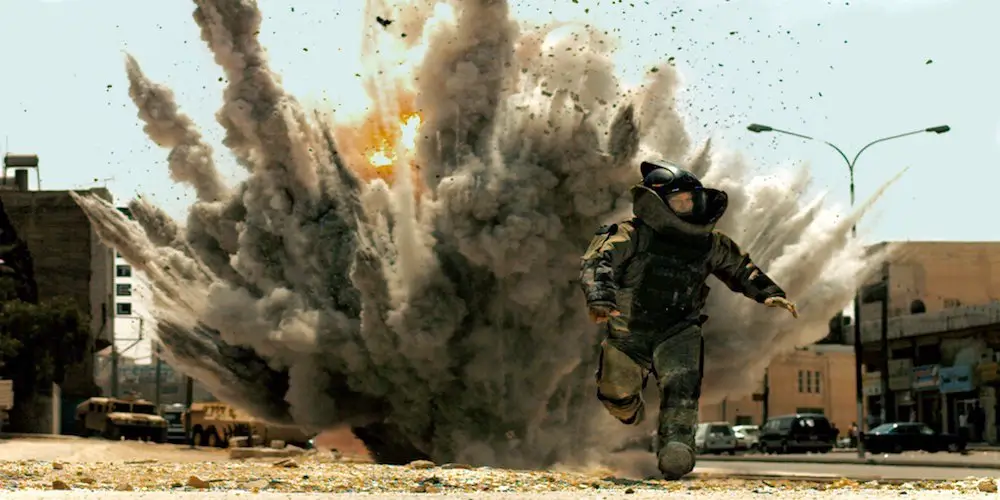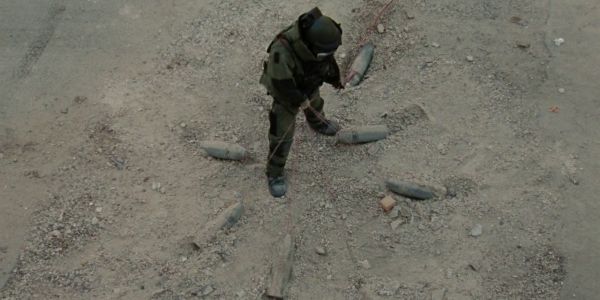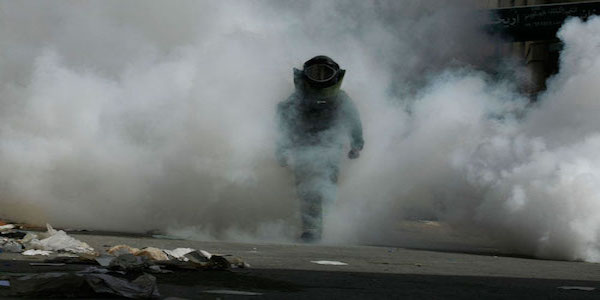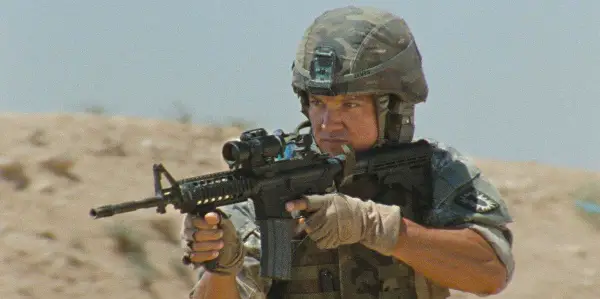Beyond The Boom Pt. 2: Storytelling With Sound In THE HURT LOCKER

Joseph Klingman is a college student of the Peach State,…
One of the most overlooked elements of the action genre is sound – more specifically, its use of sound cues to tell a story. However, this mode of storytelling is not only powerful by itself, but is especially suited to the needs of modern action films.
Recent advances in sound technology now make it possible for action directors to put sound cues to their full use. In the second part of this series (find the first here), I look at storytelling-by-sound in Kathryn Bigelow’s acclaimed 2009 war thriller, The Hurt Locker.
Who Does Sound?
We know what sound does, but who is responsible for doing sound? In short terms, sound is the job of the “sound designer,” a post-production staffer responsible for coordinating music, sound effects, dialogue editors, and working with the director to achieve the desired aural qualities of a film.
As is common knowledge, sound is captured on-set by, “boom operators,” and organized by, “sound mixers.” Beyond this, “foley artists,” fill in the gaps by re-creating sound effects or designing new ones. Yet, while these roles are important, the ultimate creative decisions for a film’s sound rest on the sound designer. One sound designer describes it thus: “My job encompasses all the aural elements of [an audience’s] suspension of disbelief… [involving] an understanding of how that sound will be heard… and how to use that knowledge to take them on the journey of the story.”
(For more info, I here point to my two sources: FilmSound.org’s definition of the role, and a more theatre-oriented article from the Association of Sound Designers. The Wiki page is also a good source-head.)
With that knowledge, the strategic use of sound in Kathryn Bigelow’s The Hurt Locker may be more aptly credited to sound designer Paul N. J. Ottosson, who received two Oscars for his sound work in The Hurt Locker and Zero Dark Thirty, among other award nominations for works such as Fury and Spider-Man 2. In each, Ottoson’s use of sound brings the audience right into the line of fire.
A Visceral, Modern Battlefield
The Hurt Locker follows a team of Explosive Ordnance Disposal technicians stationed near Baghdad during the Iraq War. Traumatized by the recent loss of their former commander to a roadside bomb, SGT. J.T. Sanborn (Anthony Mackie) and SPC. Owen Eldridge (Brian Geraghty) find themselves rushing back into the danger zone with a replacement: Afghanistan veteran, SFC. William James (Jeremy Renner).
The latter seems to enjoy nothing more than donning his bomb suit and getting up close and personal with threat after potential threat. But, as the film progresses, the constant intensity and stress of war eventually take effect on each of them in varied ways. In this intensely psychological and enthralling action thriller, sound cues are used for three key storytelling purposes: establishing specific locations, isolating the audience in characters’ individual experiences, and promoting a sense of realism.
Firstly, the film uses sound cues to give the audience a sense of place within its version of wartime Baghdad. Rather than presenting it as a cohesive whole (already familiar to most Americans through news footage), sound cues separate various locations within the world, between which the characters must travel. For each establishing shot of a new location, a set of sound cues is paired, allowing the audience to easily follow the action from place to place simply by ear.

At the film’s opening, the streets of Baghdad are paired with a thoroughly third-world din. Roaming animals, car horns, and garbled voices are intermixed, overarched by strands of Arabic. The suggestion here: this place is chaos, foreign and dirty. Into this mess drives the order-establishing U.S. Army, sweeping the crowds and cars away to a safe distance, and only then does the din decrease. Soon after, the U.S. “Camp Victory” provides a contrasting aural environment. Heavy military vehicles are always rumbling around. The sounds of fighter jets and helicopter gunships overhead signal protection from above. Tight blocks of soldiers hustle by, chanting PT drills at a jog. Everything is moving, and these sounds follow the characters whether indoors or outside on base.
The Iraqi countryside is different yet again. Unearthly silence prevails outside the crunching tires of the Humvee, signaling the sun-bleached desolation of uninhabited sand hills. Bugs, and the occasional goat herd are audible when near, but even they are sparse in the heat. Later, the scene of an exploded suicide bomb is even more unearthly, almost hellish to the ears. Fire crackles on rubble here and there, charring the remains of a fuel tanker. The screams of women and men, wounded or traumatized, punctuate in unintelligible Arabic. Only by leaving this place do the characters escape the harrowing sights and sounds.
Finally, the audience catches an auditory glimpse of life on the homefront. A shopping mall’s muted pop music and buzzing fluorescents blend with squeaky cart wheels and the static from a TV set. The unique sounds of water (wholly absent in Baghdad) appear in the form of rain, a full kitchen sink, and the sop from a clogged rain gutter. Rather than peace or happiness, the whole is dull, dreary, even empty. As listed, these sounds are unique to each location and never cross, subtly describing aspects of each place to the audience, and providing a subconscious reference point for later appearances.
Up Close with the Bomb
Secondly, specific sound choices are used to isolate the audience in the personal experiences of each character. In key moments, the tight focus of the camera is mirrored by tightly curtailed sound, cutting out all background noise and magnifying everything the character hears. Dialogue is crisp and loud as all movements register as fabric swishing and armor-vest shifting and weapons click and ching as they are readied for combat. Thereby, the audience is forced into the claustrophobic aural surroundings of each character in the moment.
To begin with, Sanborn and Owen are in focus at multiple points in the film. Subverting their intermittent machismo banter, the audience hears them shift uneasily as they scan the dangerous streets of Baghdad. In other scenes, audiences are put inside the famed EOD bomb suit by way of sound. The first instance follows the ill-fated former commander of the team, whose kevlar-padded waddling and heavy-helmeted breathing can be heard as he cautiously approaches his final detonation. James’ time in the suit is treated similarly.

The bomb defusals themselves are heard with the highest focus and intensity, with the audience’s ear almost right on the bomb. Every tick, scrape, and crunch of the military-grade ordinance and sinewy wires — whether buried under sand, wired into a car, or hidden in a fresh corpse — is heard, and indeed felt, by the audience. Beyond this, even the few firefights in the film put the audience right on the shoulders of the central characters, rather than in a more comprehensive god’s-eye view.
Sniper shots in the distance are mere echoes following the thud of a round to the chest, while the heavy machine gun atop a “humvee” responds with appropriate thunder. Later, a tight alleyway search ends in a few ringing shots from James’ and Sanborn’s assault rifles, though the enemy insurgents flee the scene in silence.
These elements are heard in almost complete isolation from the ambient sounds of the location, and push the reader as close as possible to the sensory experience of the characters themselves. The viewer is shot straight to the limits of intensity, right into the danger zone, by strategic use of sound.
War Like You’re Really There
Thirdly, sound choices are used to establish a sense of realism about the film’s battlefield environments. Rather than flooding the audience with stylized action-combat clichés, the film takes a minimalist approach, using only subdued, naturally-occurring sounds to create a look at the Iraq War as it really was. The choices of when and how much sounds are used seem more important than the nature of the sounds themselves.

The two above sections have dealt with specific types of sounds and their pairings with certain locations or characters. But generally speaking, none of the sounds seem all that out of place or uncommon. In daily life, we commonly ignore jets passing overhead and trucks rumbling by, hence, the sound of clothes moving and guns clicking is assumed when either are present.
Beyond what the audience expects of Baghdad, the aural world of the film remains intentionally close to real life, effectively minimizing the gap across which the audience must suspend its disbelief. Not only does it sound like war, but it sounds like real life; sonically, there is no reason it shouldn’t be.
Further, the absence of sound is used effectively to simulate the eerie quiet often felt before real life military conflicts. Rather than by score or sound cue, major scenes are intensified simply by the absence of sound. An early bomb blast, fatal to one officer, is preceded by one such intense hush. The characters anticipate with verbal warnings, but they shout into a vacuum — there is no echo, no quickening score, nothing but silence until the blast.
Later, an unexpected detonation is similarly foreshadowed: another unfortunate character, unaware of danger, continues to talk normally. But all else is silent, and the characters know it. Only after a few seconds of this quiet does the bomb detonate.
This use of silence as a cue becomes the audience’s proxy sixth sense. And, rather than breaking the illusion of reality, the cue actually supports it (by providing a realistic subconscious sensation) even as it communicates. The audience very quickly recognizes silence as an omen that something is soon to go wrong and is led to anticipate a major turn in the plot simply by this sonic cue.
Conclusions
To conclude, Kathryn Bigelow’s The Hurt Locker illustrates sound’s power to enhance a film’s story, and its adeptness for the action genre specifically. Through denoting specific locations in an already-familiar world, sound cues re-establish a sense of foreignness, while informing the viewer about the locations and providing aural reference points for their future use.
In isolating the characters’ own experiences, sound helps to immerse the viewer deep into the moment as though present with the character. And by closely imitating real world qualities, even to its occasional and eerie silences, sound reinforces a sense of realism and plays into a visceral sense of tension.
Taken aside the previous section of this series (featuring Mad Max: Fury Road), sound is shown to be an incredibly efficient and powerful tool in storytelling in the action genre. Though these two films are on entirely different sides of the spectrum — one fantastic, the other realistic — both films use sound to their advantage. Again, the critical success of both films must, on some level, be attributed to their storytelling with sound.
Watch for the final part of this series, in which I will turn to an evaluation of Paul Greengrass’ new action film Jason Bourne, on the basis of its use of sound. Keep listening to movies!
What sound elements did you find most revealing of story or character in The Hurt Locker? In what ways do they differ from Mad Max: Fury Road’s methods? Let me know in the comments!
Does content like this matter to you?
Become a Member and support film journalism. Unlock access to all of Film Inquiry`s great articles. Join a community of like-minded readers who are passionate about cinema - get access to our private members Network, give back to independent filmmakers, and more.
Joseph Klingman is a college student of the Peach State, a native of the Sunshine State, and the possessor of an ever-contemplative State of Mind. He spends his time on many hobbies in numerous media, but finds himself always picking about the wonderful worlds of film and storytelling.












